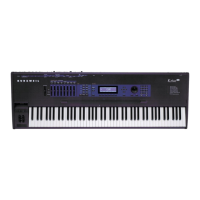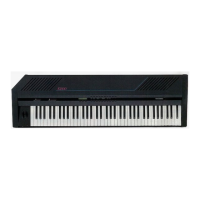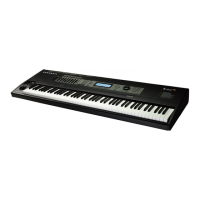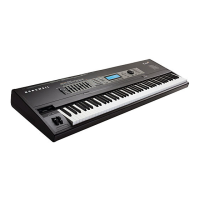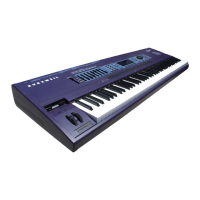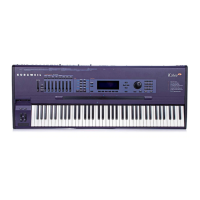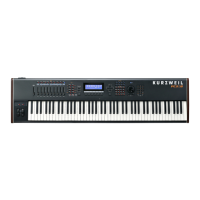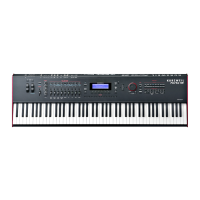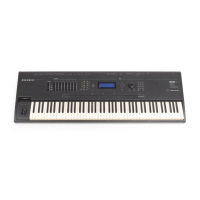Do you have a question about the Kurzweil MPS10 and is the answer not in the manual?
Key safety guidelines for operating the apparatus, covering water proximity, cleaning, and heat sources.
Instructions for safe product placement, ventilation, power connection, and radio interference.
Details the operation and purpose of individual buttons on the MPS10's front panel.
Explains how to use pairs of buttons simultaneously for advanced functions.
Highlights specific buttons and their roles in accessing special features and adjustments.
Lists the key capabilities and specifications of the Kurzweil MPS10 digital piano.
Step-by-step guide on how to power on the MPS10 digital piano correctly.
Instructions for adjusting the instrument's volume level for optimal listening.
Methods for choosing instrument sounds from the MPS10's voice library.
A comprehensive catalog of all available instrument voices with assigned keyboard keys.
Identifies the controls required to activate and manage the layering function.
Explains how to combine two different instrument sounds for richer tones.
Lists the buttons necessary for activating the keyboard split function.
Details how to divide the keyboard into two zones with different voices.
Provides practical examples and suggestions for using the split function.
Covers various adjustable parameters accessed via the Function button pair.
Identifies the buttons involved in the transpose function.
Explains the concept and utility of transposing the keyboard's pitch.
Step-by-step guide on how to change the keyboard's pitch.
Illustrates a practical scenario for using the transpose feature.
Lists the buttons required to control the rhythm function.
Describes the MPS10's rhythm patterns and how to select and play them.
Demonstrates how to use the rhythm function effectively with tempo and volume adjustments.
Identifies the buttons used for recording performances on the MPS10.
Explains the MPS10's capability to record and playback musical performances.
Provides a step-by-step guide for recording user performances on the instrument.
Offers important considerations and tips for recording, including metronome and rhythm usage.
Lists the buttons used to access and control demo songs.
Introduces the demo mode and its purpose for showcasing piano songs.
Explains how to activate the demo song playback mode.
Details how to navigate, play, stop, and skip through demo songs.
A list of all available demonstration songs with their assigned keys.
Describes the function of the included sustain pedal.
Provides instructions on how to connect and position the sustain pedal.
Explains the sustain pedal's role in prolonging note sounds after key release.
Defines MIDI and its relevance for connecting musical instruments.
Explains how to connect the MPS10 to a computer via USB for MIDI communication.
Details how to use the MPS10 with computer-based sequencer programs.
Explains how MIDI channels work for transmitting performance data.
Information on using the headphone jacks for private practice.
Instructions for connecting external audio sources to the MPS10.
Details on connecting the MPS10 to external amplifiers or recorders.
Step-by-step instructions for assembling the MPS10 keyboard stand.
Guide for attaching the music rack to the MPS10 keyboard.
Technical chart detailing MIDI communication protocols and parameters.
A comprehensive list of the MPS10's hardware and software features.
Key safety guidelines for operating the apparatus, covering water proximity, cleaning, and heat sources.
Instructions for safe product placement, ventilation, power connection, and radio interference.
Details the operation and purpose of individual buttons on the MPS10's front panel.
Explains how to use pairs of buttons simultaneously for advanced functions.
Highlights specific buttons and their roles in accessing special features and adjustments.
Lists the key capabilities and specifications of the Kurzweil MPS10 digital piano.
Step-by-step guide on how to power on the MPS10 digital piano correctly.
Instructions for adjusting the instrument's volume level for optimal listening.
Methods for choosing instrument sounds from the MPS10's voice library.
A comprehensive catalog of all available instrument voices with assigned keyboard keys.
Identifies the controls required to activate and manage the layering function.
Explains how to combine two different instrument sounds for richer tones.
Lists the buttons necessary for activating the keyboard split function.
Details how to divide the keyboard into two zones with different voices.
Provides practical examples and suggestions for using the split function.
Covers various adjustable parameters accessed via the Function button pair.
Identifies the buttons involved in the transpose function.
Explains the concept and utility of transposing the keyboard's pitch.
Step-by-step guide on how to change the keyboard's pitch.
Illustrates a practical scenario for using the transpose feature.
Lists the buttons required to control the rhythm function.
Describes the MPS10's rhythm patterns and how to select and play them.
Demonstrates how to use the rhythm function effectively with tempo and volume adjustments.
Identifies the buttons used for recording performances on the MPS10.
Explains the MPS10's capability to record and playback musical performances.
Provides a step-by-step guide for recording user performances on the instrument.
Offers important considerations and tips for recording, including metronome and rhythm usage.
Lists the buttons used to access and control demo songs.
Introduces the demo mode and its purpose for showcasing piano songs.
Explains how to activate the demo song playback mode.
Details how to navigate, play, stop, and skip through demo songs.
A list of all available demonstration songs with their assigned keys.
Describes the function of the included sustain pedal.
Provides instructions on how to connect and position the sustain pedal.
Explains the sustain pedal's role in prolonging note sounds after key release.
Defines MIDI and its relevance for connecting musical instruments.
Explains how to connect the MPS10 to a computer via USB for MIDI communication.
Details how to use the MPS10 with computer-based sequencer programs.
Explains how MIDI channels work for transmitting performance data.
Information on using the headphone jacks for private practice.
Instructions for connecting external audio sources to the MPS10.
Details on connecting the MPS10 to external amplifiers or recorders.
Step-by-step instructions for assembling the MPS10 keyboard stand.
Guide for attaching the music rack to the MPS10 keyboard.
Technical chart detailing MIDI communication protocols and parameters.
A comprehensive list of the MPS10's hardware and software features.
| Number of Keys | 88 |
|---|---|
| Key Action | Weighted Hammer Action |
| Polyphony | 128 |
| Display | LCD |
| General MIDI | Yes |
| Splits/Layers | Yes |
| Transpose | Yes |
| Tune | Yes |
| Metronome | Yes |
| Recorder/Sequencer | Yes |
| Demo Songs | Yes |
| Finish | Black |
| Effects | Reverb, chorus, EQ |
| Connectivity | USB, MIDI, headphones |
| Headphones | 1/4" jack |
| Pedal | Sustain pedal |
| Included Accessories | Power adapter |
| Sounds/Preset Programs | 64 Factory Presets |
